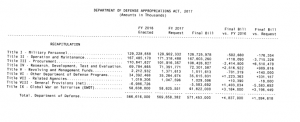Click to view a PDF version of this factsheet.
On March 2, 2017, the House Appropriations Committee released a copy of the Fiscal Year 2017 Defense Appropriations conference report. The House is scheduled to take up the conference report the week of March 6; the Senate could take up the measure sometime after that.
Currently, Defense Appropriations are operating under a Continuing Resolution (CR), which preserves most defense spending at FY16 levels. This CR is set to expire April 28, 2017.
For the text of the Legislation, click here.
For the Explanatory Statement of the Legislation, click here.
Last year, the House passed the bill but the Senate did not.
The new measure provides $577.9 billion, including $61.8 billion for overseas contingency operations. With this bill, the Pentagon budget for FY 2017 now totals $583.7 billion, adding in emergency money included in last year’s Continuing Resolution, an increase of $10.9 billion over FY 2016.
This figure does not include other programs formally considered in the “050” national security budget, including the nuclear weapons portion of the Department of Energy budget and military construction. However, there is expected to be an additional defense supplemental of about $30 billion submitted to Congress later this month.
Some Highlights of the Bill
Nuclear weapons programs:
Includes $1.5 billion for the Ohio replacement strategic nuclear submarine.
Funds $1.3 billion for the long-range strike bomber program.
Provides for $968 million for the ballistic missile defense mid-course system currently based in Alaska and California.
Funds the requested $326 million for the Cooperative Threat Reduction arms control and WMD non-proliferation programs.
Conventional weapons programs:
Added unrequested $979 million for a dozen F/A-18 Super Hornet aircraft.
Added 11 additional F-35 aircraft, bringing the total buy to 74.
Continues to prohibit the use of funds to retire the A-10 close air support fleet.
Funds $3.6 billion for the DDG-51 destroyer program, an increase of $404 million from the request.
Provides $1.6 billion for the Littoral Combat Ship, $438 million above the request and an increase of one additional ship.
Other provisions and programs:
A 2.1% pay increase rather than the requested 1.6% for the military.
Continues to prohibit the use of funds for Base Realignment and Closure (BRAC) (Section 8123).
Provides the requested $3.4 billion for the European Reassurance Initiative.
Provides Israeli missile defense $600.7 million, an increase of $113.1 million over last year’s enacted level. (Section 8072)
Approves $150 million for lethal and non-lethal aid to Ukraine to counter Russian aggression (Section 9014).
Fully funds $6.7 billion for cyberspace activities.
Adds funding for an additional 1,000 active-duty Army soldiers, 1000 Army Reserve soldiers, 1,000 Army National Guard soldiers, and 1,000 Marines.
Prohibits the use of funds for gaming or entertainment that involves nude entertainers. (Section 8122)
Prohibits the use of funds to implement the Arms Trade Treaty until the treaty is ratified by the Senate (Section 8112).
(Chart Source: Page 350 of DOD Appropriations Conference Bill FY2017)
Sources: In addition to the text of the resolution and companion explanatory statement, this analysis referenced a press release by the House Appropriations Committee and a summary provided by the Senate Appropriations Committee.

